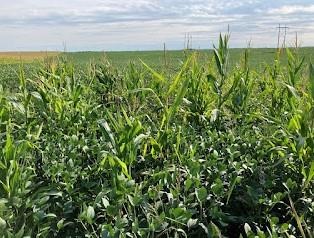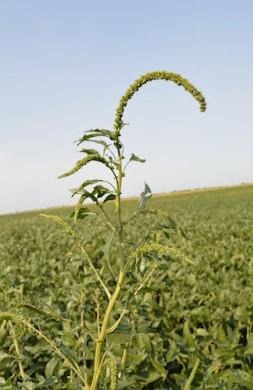By Seth Naeve and Dave Nicolai et.al
The 2022 soybean crop has been no cakewalk for Minnesota producers. A cold and wet early spring led to some significant delays in getting the crop planted. In the rare areas where soybeans could be planted in a timely manner, continued rains delayed preemergence herbicide applications. In other areas, planting only occurred after the rains stopped, and the herbicides did not get good rainfall to activate right away. A dry summer then followed for most regions of Minnesota.
With delayed planting and dry conditions, nearly every field of soybeans in the state was behind and short most of the year. Poor canopy development has allowed waterhemp, volunteer corn, and other weeds to establish and poke out of the canopy in fields statewide.
Do these weed escapes really matter?
While farmers all strive for clean fields, it is likely that the sporadic escaped weeds had little effect on this years’ soybean yields. These weed escapes do have an impact, however. Economic impacts can occur at the local elevator as well as thousands of miles away via export markets. These escapes will also exacerbate weed problems in the future if they are able to produce viable seeds. The good news is that it isn’t too late to keep these weedy plants out of the combine and out of the commodity stream.

Patch of volunteer corn in a soybean field.
Volunteer corn, a weed in soybeans, competes for
resources, adds foreign material to the harvested
soybeans, and minimizes crop rotation benefits.
Herbicide resistance is common in many of Minnesota’s weed species. The best long-term strategy for fighting weeds is to whittle down the weed-seed bank. Even small escaped pigweeds can return thousands of seeds to the soil.
Ideally, weeds should be pulled prior to harvest and removed from fields if seeds have been produced. However, this may not be a realistic option in many situations. If weeds are present in patches, consider mowing these areas to isolate the weed seed to a limited area where it can be carefully monitored and managed in subsequent crops. Running weed patches through the combine this fall will do an excellent job of dispersing these troublesome weeds throughout the field and into the next one, which is something that no one would want.
Impact on exports
International customers of US soybeans, including China, are rejecting soybean shipments carrying more than one percent foreign material (FM). Since FM includes any material that is not soybean seed, weed seed is an important factor. In fact, the limits on FM in soybean imports are focused on weed seed and other crop seeds, like corn. Weed seed found in shipments will likely lead to rejection of entire vessels. Rejected vessels are extremely costly for the exporter who will certainly turn around and push costs back through the system to the farmer.
Annually, the Naeve Lab at the University of Minnesota analyzes up to 2000 soybean samples from US producers for a wide range of quality traits, including FM and weed seed. Although FM tends to be very low (~0.2% on average), around 25% of the samples contain weed seed, indicating famers are still combining plenty of weeds.
Weeds love combines
Part of the problem is that our common weeds retain seeds until crop harvest, meaning a large percentage of weed seeds pass through the combine. Combines are great at accumulating dust, crop residue, and weed seeds. Research from the University of Wisconsin has documented how important combines are in spreading weed seeds. Of the 31 samples collected from within nine different combines, 97% of them contained viable weed seed. The weed seed most often found included grasses, pigweeds and common lambsquarters. Sanitizing combines between fields can minimize the spread of weeds. Focus sanitation efforts towards the front of the combine if time is limited. The greatest number of weed seeds were found on the header, followed by the feeder house, rock trap, and rotor. Taking even just a small amount of time to clean out combines between fields can be helpful in minimizing the spread of weed problems.

Escaped waterhemp plant in a Minnesota
soybean field. Controlling weeds before
seed production helps minimize inputs into
the weed seed bank.
Keeping weeds out of combines has multiple benefits
Efforts to produce high-quality, weed-free grain serves a dual purpose. Keeping weeds out of soybean fields and out of combines will help maintain important market access while simultaneously improving weed management. Preventing weed seeds from entering the combine is a foundational component for long term weed management, especially when those weeds are herbicide resistant.
To increase awareness about challenges with FM in soybean while managing herbicide resistant weeds, we have developed a series of six video segments from crop planting through harvest and transportation. View UM Extension's entire Managing foreign material video series for more information. Be sure to catch the videos on post-harvest weed management and grain handling as harvest will soon be upon us.
Source : umn.edu